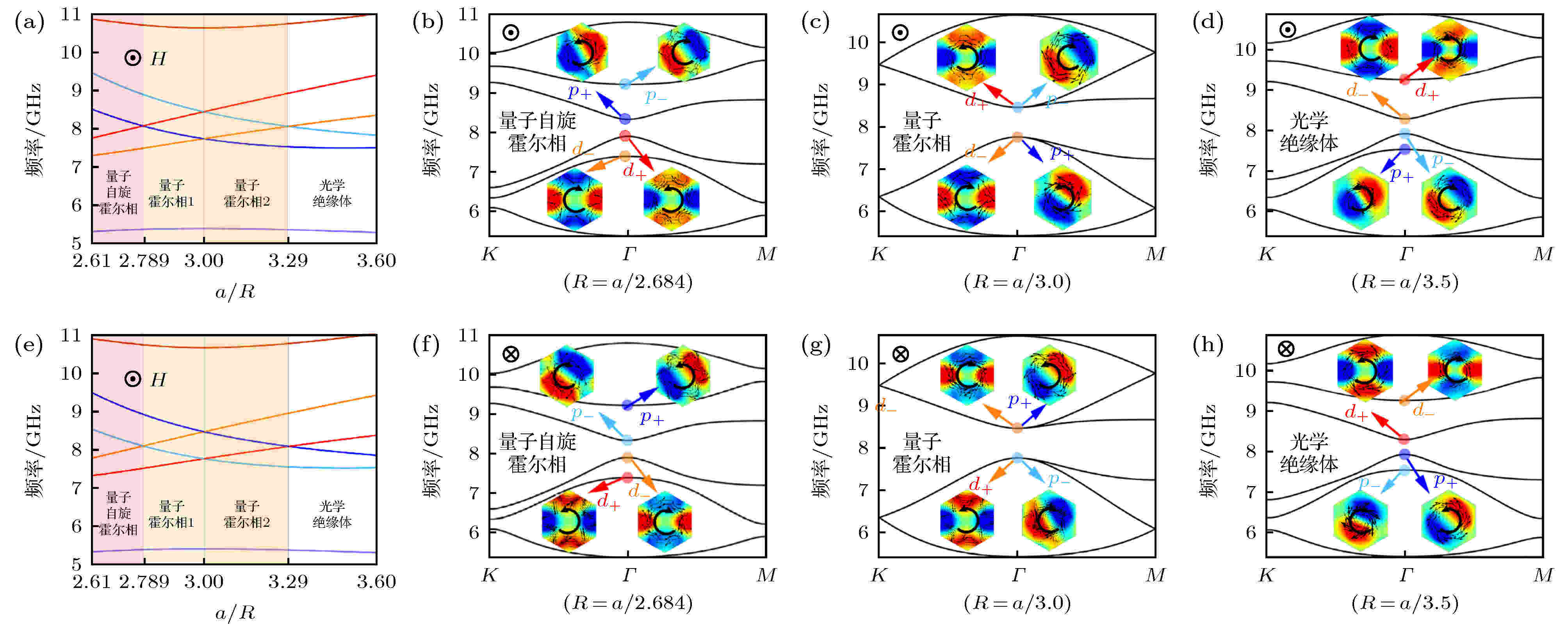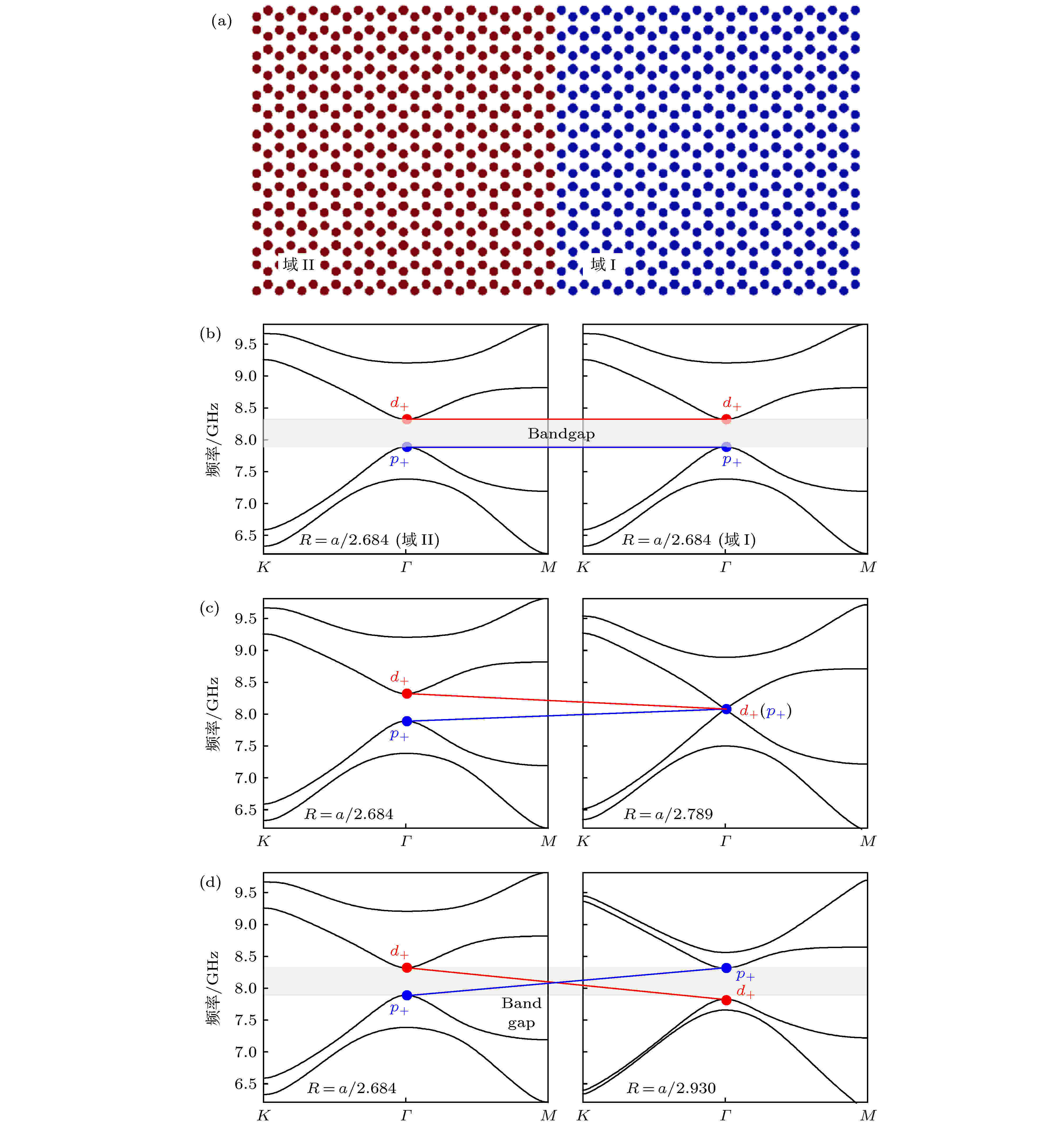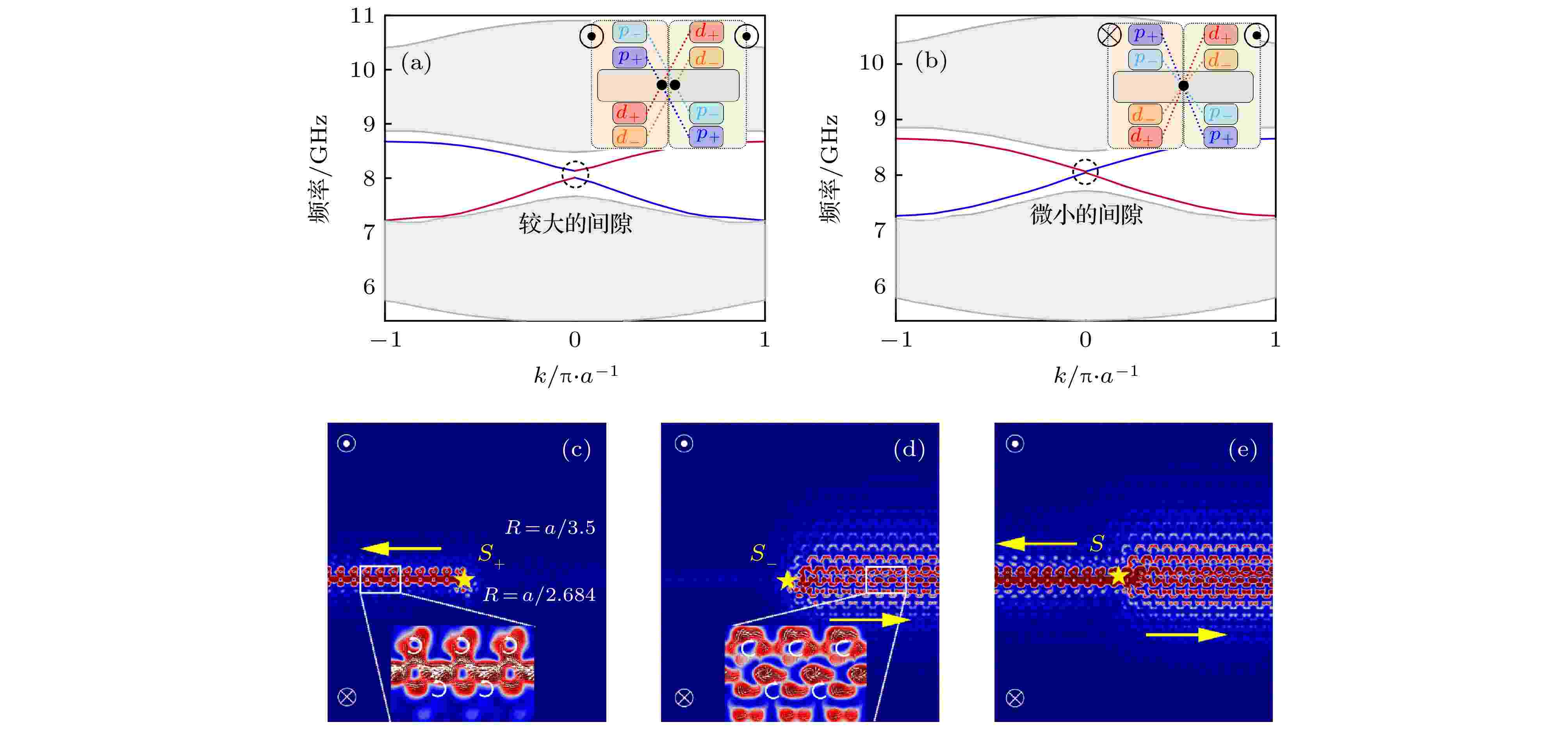全文HTML
--> --> -->与电子系统相似, 光子晶体中同样具有多种拓扑相, 如量子霍尔相[2-11]、量子自旋霍尔相[12-16]和量子谷霍尔相[17-24]等. Raghu和Haldane[2,3]最早在理论上预见了当打破时间反演对称性后, 二维光子晶体带隙会具有非零拓扑不变量, 它类比为电子系统中的量子霍尔效应. 这一思想很快由Wang等[4,5]利用二维磁性光子晶体在微波频段进行了实验验证, 观测到了具有鲁棒性单向传输特征的边界态. 之后, 各种关于光子晶体的量子霍尔相及其应用被不断地提出或得到实验验证[7-11].
人们发现带隙拓扑性质的改变总伴有能带带序上的反转, 而带序的变化可以由能带上本征态的模式分布加以确定, 故而光子晶体中的拓扑相可以通过构建特定的能带带序结构加以实现. 例如, 在时间反演对称性保持不变的体系中, 人们发现打破赝时间反演对称性可以实现具有1/2赝自旋态的光学量子自旋霍尔相. 打破赝时间反演对称性使得能带带序发生反转, 实现了从光学绝缘相到量子自旋霍尔相的转变[12-16]. 这种方案最早由Wu等[12]提出, 它通过改变蜂窝结构的半径来打破赝时间反演对称性. 这种方法在微波频段下得到了实验证实[13], 观测到了光子晶体板边缘存在与赝自旋相关的单向边界态. 这类光子拓扑绝缘相的拓扑性质对光子晶体边缘的晶格完整性敏感, 故在投影能带中的边界态并不是严格无带隙的[1,12-16]. 类似地, 研究人员发现在蜂窝结构中打破空间反演对称性可以实现量子谷霍尔相. 打破空间反演对称性使得能带带序在K和K′ 能谷处发生反转, 从而实现了两种量子谷霍尔相的相互转换, 这两种量子谷霍尔相具有相反的谷陈数

对于磁性光子晶体而言, 改变能带带序的办法可以是改变偏置磁场大小或光子晶体结构. 本文讨论了偏置磁场的方向对磁性光子晶体能带结构, 特别是带序结构的影响. 结果表明: 改变偏置磁场的方向会使得能量不同但宇称相同的本征态之间发生交换, 从而使得能带结构中出现带序交换. 利用这一特点, 可以在两个光子晶体的边界上构建出不同特性的拓扑边界态并调控边界态的传输特性. 在边界上是否出现拓扑保护的边界态及边界态的主要特性可以用边界两侧光子晶体体能带的相对关系直接判断. 利用偏置磁场方向改变能带带序的方法将有助于加深我们对能带结构的理解, 构建出所需要的拓扑边界态.




 图 1 (a)二维光子晶体示意图, 其中黄色的圆表示空气背景中的铁氧体柱, 黑色六边形表示阵列结果中的一个基元; (b) H = 0和R = a/3时的能带结构, 在Γ点具有一个四重简并点; (c) H ≠ 0和R = a/3时的能带结构(由于打破时间反演对称性, 能带结构中出现了完全带隙, 并在Γ点出现了两个双重简并点); (d) H ≠ 0和R ≠ a/3时的能带结构
图 1 (a)二维光子晶体示意图, 其中黄色的圆表示空气背景中的铁氧体柱, 黑色六边形表示阵列结果中的一个基元; (b) H = 0和R = a/3时的能带结构, 在Γ点具有一个四重简并点; (c) H ≠ 0和R = a/3时的能带结构(由于打破时间反演对称性, 能带结构中出现了完全带隙, 并在Γ点出现了两个双重简并点); (d) H ≠ 0和R ≠ a/3时的能带结构Figure1. (a) Schematic of two-dimensional magnetic photonic crystal fabricated by ferrite rods (denoted by yellow circles) embedded in air background. The black hexagon denotes the basis of the array. (b) Band structure at H = 0 and R = a/3. A four-fold degeneracy point shows at the Γ point. (c) Band structure at H ≠ 0 and R = a/3. A full bandgap presents in the band structure because of time reverse symmetry broken, and two doubly degeneracy points present at Γ point. (d) Band structure at H ≠ 0 and R ≠ a/3.







由于晶格结构的C6对称性, 在布里渊区中心点












 图 2 正向和反向偏置磁场时, Г点处四个本征态的电场相位分布和磁场(反转偏置磁场的方向将使得本征态的电场相位和磁场在形式上出现p+和p-, d+和d-之间的交换)
图 2 正向和反向偏置磁场时, Г点处四个本征态的电场相位分布和磁场(反转偏置磁场的方向将使得本征态的电场相位和磁场在形式上出现p+和p-, d+和d-之间的交换)Figure2. Magnetic fields and the phase of electric fields for the eigenstates p+, p-, d+, d- at the Г point. Reversing the direction of bias magnetic field causes the exchange in the profiles of electric phase and magnetic field.
考虑横向电场(TE)极化的电磁波(即交变电场沿z方向), 电磁场可表示为:











图3给出了在正反磁场两种情形下p态和d态次序是如何随着R发生改变的. 图3(a)给出了位于





 图 3 (a)当偏置磁场沿着+z方向时, Г点的p态和d态的本征频率随参数a/R的变化(随着a/R的增加, Г点处发生能带带序反转, 并伴随着拓扑相变; 不同颜色的阴影显示三种不同的拓扑相); (b)?(d)分别是当光子晶体处于量子自旋霍尔相(R = a/2.684)、量子霍尔相(R = a/3)和光学绝缘相(R = a/3.5)时的能带结构; 图中的插图是能带结构对应点上的场模式图, 其中黑色箭头表示坡印亭矢量; (e)?(h)是当偏置磁场沿着–z方向时, 本征频率随a/R的变化, 以及三种典型的拓扑相的能带结构和场模式
图 3 (a)当偏置磁场沿着+z方向时, Г点的p态和d态的本征频率随参数a/R的变化(随着a/R的增加, Г点处发生能带带序反转, 并伴随着拓扑相变; 不同颜色的阴影显示三种不同的拓扑相); (b)?(d)分别是当光子晶体处于量子自旋霍尔相(R = a/2.684)、量子霍尔相(R = a/3)和光学绝缘相(R = a/3.5)时的能带结构; 图中的插图是能带结构对应点上的场模式图, 其中黑色箭头表示坡印亭矢量; (e)?(h)是当偏置磁场沿着–z方向时, 本征频率随a/R的变化, 以及三种典型的拓扑相的能带结构和场模式Figure3. (a) Evolution of p and d eigenstates at point Г as a function of the radio of a/R with the bias magnetic field in the +z direction. As a/R increases, the band order exchange takes place where phase transition happens. Three types of phases are shaded in different colors. (b)?(d) Typical band structures of quantum spin-Hall (QSH) phase (R = a/2.684), quantum Hall (QH) phases (R = a/3), and conventional insulator (CI) phase (R = a/3.5). (e)?(h) The same as (a)?(d), but the bias magnetic field is in the –z direction. The insets of the panels (b)?(d) and (f)?(g) are the profile of eigenstates at the corresponding dots on the band structure of the panels, where the black arrow indicates the Poynting vectors.
图3(e)展示了偏置磁场反向时, 能带结构在




边界态的特性不仅取决于域所处的拓扑相, 还取决于边界两侧拓扑相能带的相对关系. 考虑两个区域都处于量子霍尔相, 但它们的参量R分别是a/2.93和a/3.09, 并且偏置磁场方向相同. 此时, 两个区域的共同带隙两侧虽然有不同的能带带序(见图3(a)), 但是在域边界上并没有出现边界态(见图4(a)). 如果改变域I中偏置磁场方向, 其能带带序将从




 图 4 偏置磁场方向对边界态的影响(区域I和II均处于量子霍尔相, 但结构参量R分别是a/2.93和a/3.09) (a)两个区域施加同向偏置磁场时的投影能带结构; (b)和(c)分别用激发源S+和S–激发时的场分布; (d)两个区域施加反向偏置磁场时的投影能带结构; (e)和(f)分别用激发源S+和S–激发时的场分布, 其中的放大图展示了电磁波的轨道角动量特性, 图中箭头表示坡印亭矢量(当两个区域施加反向偏置磁场时, S+和S–都可以激发沿同一方向传播的单向波); (a)和(d)图中的插图给出了两个区域中能带结构的对应关系, 两块域中相同的本征态连线连的交叉点出现在共同带隙中时将出现拓扑边界态
图 4 偏置磁场方向对边界态的影响(区域I和II均处于量子霍尔相, 但结构参量R分别是a/2.93和a/3.09) (a)两个区域施加同向偏置磁场时的投影能带结构; (b)和(c)分别用激发源S+和S–激发时的场分布; (d)两个区域施加反向偏置磁场时的投影能带结构; (e)和(f)分别用激发源S+和S–激发时的场分布, 其中的放大图展示了电磁波的轨道角动量特性, 图中箭头表示坡印亭矢量(当两个区域施加反向偏置磁场时, S+和S–都可以激发沿同一方向传播的单向波); (a)和(d)图中的插图给出了两个区域中能带结构的对应关系, 两块域中相同的本征态连线连的交叉点出现在共同带隙中时将出现拓扑边界态Figure4. Influence of the direction of bias magnetic field on the edge states when two domains are in the QH phase but have different geometric structure (R = a/2.93 and R = a/3.09). (a) The projected band structure when two domains are applied by the same direction of bias magnetic field. (b) and (c) Electrical field distribution at 8 GHz excited by S+ and S–, respectively. No edge mode is excited. (d) The projected band structure when two domains are applied by the opposite direction of bias magnetic field. (e) and (f) Electric field distribution corresponding to (d) at 8 GHz excited by S+ and S–. The waves propagate unidirectional. The inset enlarges the field details which shows the orbital angular momentum of the wave. The inserts of (a) and (d) show the schematic of the relationship of the topological edge state and eigenstates in the two domains.
上述例子表明了边界态的出现与光子晶体边界两侧共同带隙附近能带带序的相对关系有关. 为了简单起见, 考虑如图5所示的情况. 如果固定域II的拓扑相不变, 使域I发生拓扑相变, 那么在两个区域的边界上必定会经历带隙的闭合以中和拓扑指数, 然后重新打开带隙. 由于域I的拓扑相变是由域中的能带带序交换引起的, 连接两个域中相同本征态将会在两个区域的共同带隙中出现交叉, 它和边界态形成过程中的能带闭合再打开过程一致. 因此, 在共同带隙中的交叉点预示着在域边界上会出现边界态. 图5给出了上述拓扑边界态出现的示意图. 当域I的拓扑相发生相变时, 连接两个域中相同的本征态的连线在它们的共同带隙中经历了分离(图5(b))、闭合(图5(c))、交叉(在带隙内出现交叉点, 如图5(d)), 重现了不同拓扑指数的光子绝缘体在其边界上经历的过程. 因此, 可以通过带隙内是否出现交叉点以及交叉点的个数来判断在边界上是否出现边界态以及边界态的数量. 图4(a)中的插图给出了两个区域在同向磁化时的能带相对关系, 由于边界两侧相同本征模式之间的连线在共同带隙中不存在交叉点, 故投影能带结构中没有边界态. 而在图4(d)插图中, 两个能带的相对关系确定了在共同带隙中存在两个交叉点, 所以在投影带结构中有两条边界态. 除此以外, 还可以通过能带相对关系示意图获得其他关于边界态的信息. 例如, 图4(d)中的两个交叉点分别由正的轨道角动量(d+, p+)模式和负的轨道角动量(d–, p–)模式相互连接构成, 所以这两条边界态分别具有正的和负的轨道角动量. 进一步, 当d+(p–)从左下方连接到右上方, 而p+(d–)从左上方连接到右下方时, 边界态会具有负的群速度. 在表1列出了四种边界态的基本情况, 其他复杂情况都可以从这四种边界态推导得出.
| 本征态 | 连接方式 | 轨道角动量 | 群速度 |
| d+ | 从左下方到右上方 | 正 | 负 |
| p+ | 从左上方到右下方 | ||
| p– | 从左下方到右上方 | 负 | 负 |
| d– | 从左上方到右下方 | ||
| d– | 从左下方到右上方 | 负 | 正 |
| p– | 从左上方到右下方 | ||
| p+ | 从左下方到右上方 | 正 | 正 |
| d+ | 从左上方到右下方 |
表1由本征态连接方式决定边界态的轨道角动量和群速度
Table1.Orbital angular momentums and group velocities determined by the linked manner of eigenstates.
 图 5 (a)由两个具有不同拓扑指数的域组合在一起形成的域边界(假设保持域II固定在量子自旋霍尔相); (b)?(d)域I从量子自旋霍尔相转变到量子霍尔相时, 域边界出现拓扑边界态的过程示意图
图 5 (a)由两个具有不同拓扑指数的域组合在一起形成的域边界(假设保持域II固定在量子自旋霍尔相); (b)?(d)域I从量子自旋霍尔相转变到量子霍尔相时, 域边界出现拓扑边界态的过程示意图Figure5. (a) Schematics of the domain boundary created by two domains with distinct topological index. Supposing the domain II keeps in QSH phase. (b)?(d) The procedure of the topological edge state creation when domain I takes place the phase transiting from QSH phase to QH phase.
对于更加一般的情况, 如两个区域分别处于量子自旋霍尔相(R = a/2.684)和光学绝缘相(R = a/3.50), 并施加方向相同的偏置磁场. 图6(a)中的插图给出了此时的能带相对关系示意图. 两个交叉点分别由正的轨道角动量(d+, p+)的模式和负的轨道角动量(d–, p–)的模式连接构成, 所以在边界上存在着两条轨道角动量相反的边界态. 这个结论和图6(a)中的投影能带是一致的. 不同于图4(d), 此处的两条边界态具有相反的群速度和轨道角动量[12-16], 这将会产生与量子自旋霍尔效应相似的赝自旋单向波. 当域II中的偏置磁场反向时, 无论交叉点的个数还是本征态的连接方式都没有改变(见图6(b)插图), 所以边界态的轨道角动量和群速度保持不变. 作为进一步的证明, 图6(c)和图6(d)分别展示了在边界上用正和负的轨道角动量的源激发的电场分布情况, 结果显示不同角动量波将会沿不同的方向传播. 而用线电流源S激发时, 具有正和负的轨道角动量的电磁波会被分开, 然后分别沿着不同的边界传播, 如图6(e)所示. 对其他用不同拓扑相以及磁场方向变化导致的带序变化构建的边界态的情况, 读者可仿照上述方法自行分析, 在此就不再一一赘述. 需要指出当域I和域II的磁化方向相同时, 共同带隙两侧光子晶体能带带序的组合是不完全的. 如果再引入磁场方向作为参量, 则可以实现所有可能的组合, 从而实现更多可能的拓扑边界态. 如何实现上述由磁场方向导致的拓扑态, 在实验上还存在着挑战. 一种可能的方法是采用永磁体来实现对偏置磁场方向的控制[28], 但是它可能会带来非均匀磁化的问题.
 图 6 区域I和II分别处于量子自旋霍尔相和量子霍尔相时, 偏置磁场方向对边界态的影响 (a)同向偏置磁场和(b)正反向偏置磁场时的投影能带结构(两条边界态具有相反的群速度和轨道角动量, 在边界上形成与量子自旋霍尔效应相似的赝自旋单向波; 采用正反向偏置磁场可以有效地减小边界态的间隙); (c) S+激发源可以实现向左边传播的单向传播; (d) S–激发源可以实现向右边传播的单向传播; (e)当S被激发时, TE波沿着两个方向传播
图 6 区域I和II分别处于量子自旋霍尔相和量子霍尔相时, 偏置磁场方向对边界态的影响 (a)同向偏置磁场和(b)正反向偏置磁场时的投影能带结构(两条边界态具有相反的群速度和轨道角动量, 在边界上形成与量子自旋霍尔效应相似的赝自旋单向波; 采用正反向偏置磁场可以有效地减小边界态的间隙); (c) S+激发源可以实现向左边传播的单向传播; (d) S–激发源可以实现向右边传播的单向传播; (e)当S被激发时, TE波沿着两个方向传播Figure6. Influence of the direction of bias magnetic field on the edge states when two domains are the QSH phase and the CI phases, respectively. (a), (b) The projected band structure for the two domains are respectively applied by the same and the opposite direction of bias magnetic field. The edge states localized at the boundary lead to a pseudo-spin dependent one-way propagation. The application of using opposite direction of bias magnetic field in the two domain reduces the gap of edge states. (c) Unidirectional wave propagation localized at domain interface excited by S+. (d) Unidirectional wave propagation excited by S–. (e) TE wave propagates along with opposite side when it is excited by S.
值得注意的是, 改变边界两侧偏置磁场的方向会明显地改变边界态电磁波的传输特性. 计算了图7(a)所示光子晶体的传输效率. 传输效率T为磁性光子晶体下方的出射电磁波功率pout和光子晶体上方的入射功率pin之比, 采取对数刻度可表示为

 图 7 (a)传输效率计算示意图; (b)与图6对应的传输效率(红线和蓝线相应于边界两侧同向和正反向偏置磁场时边界态的传输效率, 绿线和黑线是左侧光子晶体(R = a/2.684)和右侧光子晶体(R = a/3.5)单独存在时的传输效率, 阴影区为两侧光子晶体的共同带隙)
图 7 (a)传输效率计算示意图; (b)与图6对应的传输效率(红线和蓝线相应于边界两侧同向和正反向偏置磁场时边界态的传输效率, 绿线和黑线是左侧光子晶体(R = a/2.684)和右侧光子晶体(R = a/3.5)单独存在时的传输效率, 阴影区为两侧光子晶体的共同带隙)Figure7. (a) Schematic of the computational transmission efficiency. (b) The transmission efficiency corresponding to the Fig. 6. The transmission efficiency of the edge state under the condition of applying bias magnetic field with the same (red curve) or opposite direction (blue curve) in the two domains. The transmission efficiency of the full photonic crystals of the left domain is shown in green curve and the right domain in black curve. The shadow region indicates the common band gaps.
